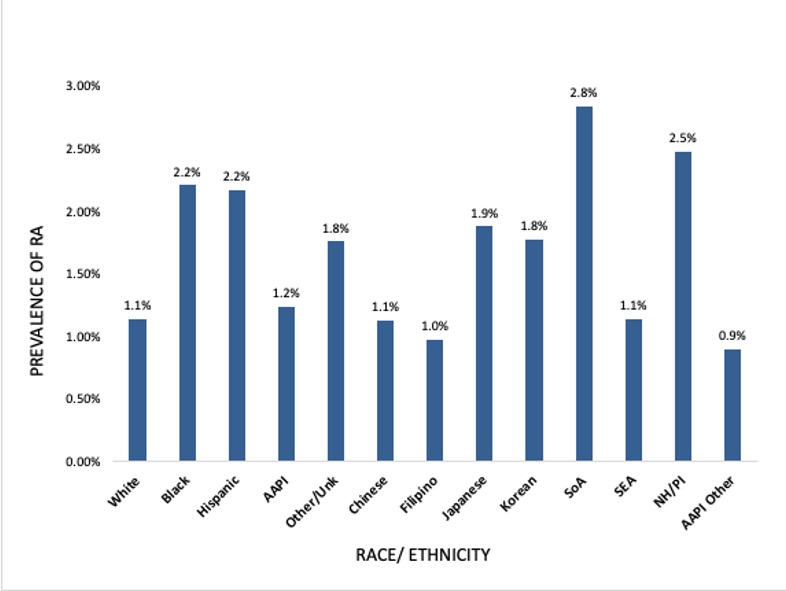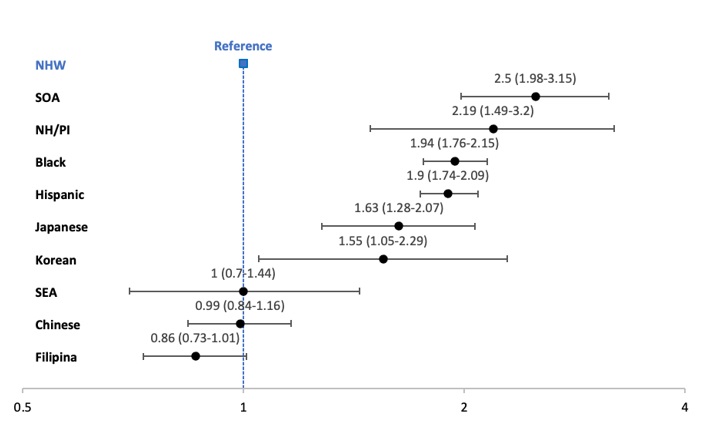Session Information
Session Type: Poster Session A
Session Time: 10:30AM-12:30PM
Background/Purpose: Rheumatoid arthritis (RA) is a disabling, autoimmune condition affecting up to as many as 17.6 million individuals worldwide. Epidemiologic evidence in the United States thus far suggests RA may be less prevalent among those of Asian and Pacific Islander (Asian/PI) descent compared to those of African or European descent. However, there are many many racial and ethnic subgroups that comprise the Asian/PI label, and aggregating these subgroups has been shown to miss inter-group differences in prevalence of many diseases. In the RA literature, this study is the first to analyze RA prevalence in the United States among disaggregated Asian/PI subgroups. Understanding the demographics of RA on this level is important in further elucidating disparities in RA diagnosis, treatment, and prognosis.
Methods: Data from population of women aged 65-85 years in Kaiser Permanente Northern California (KPNC) during 2017-2019 were examined to determine the prevalence of rheumatoid arthritis by race and ethnicity and by Asian/PI subgroups. Race and ethnicity were ascertained from self-reported data in electronic health record and administrative databases. Identification of RA was based on ICD-9/10-coded clinical diagnosis at KPNC rheumatology clinic encounters between 2017-2019. Log-binomial regression was used to estimate prevalence ratios (PR) by race and ethnicity with 95% confidence intervals (CI), adjusted for age.
Results: Among 303,340 women, 60.1% were non-Hispanic White (NHW), 6.7% Black, 8.8% Hispanic, 16.0% Asian/PI, and 8.5% Other. There were 4161 women with RA, with an overall RA prevalence of 1.4%. By race and ethnicity, the prevalence ranged from 1.1% NHW, 1.2% Asian/PI, 2.2% Black, and 2.2% Hispanic, but among Asian/PI subgroups, the prevalence ranged from 1.0% Filipina, 1.1% Chinese, 1.1% Vietnamese or other Southeast Asian, 1.8% Korean, 1.9% Japanese, 2.5% Native Hawaiian/PI, NHPI, and 2.8% South Asian (Figure 1). The corresponding PRs with NHW as reference (Figure 2), were Black 1.9, Hispanic 1.9, Filipina 0.9, Chinese 1.0, Southeast Asian 1.0, Japanese 1.6, Korean 1.6, NHPI 2.2 and South Asian 2.5.
Conclusion: Compared to NHW women, this study demonstrated RA prevalence was 1.9-fold higher for Black and Hispanic women but similar for aggregated Asian/PI women. However, disaggregated findings in our study among Asian/PI subgroups showed 1.6-fold higher prevalence among Japanese and Korean women and >2-fold higher prevalence among South Asian and NHPI women compared to NHW women. This study elucidates how aggregating racial categories obscures heterogeneity amongst the subgroups. Prior studies have found meaningful clinical differences by racial categories in more than just RA prevalence. For example, minority groups were found to have higher RA disease activity scores and lower rates of remission. This knowledge gap in the epidemiology of RA hinders our comprehension of the clinical impact of RA and the existence of health disparities among Asian/PI RA patients. Future studies should examine whether characteristics of RA such as initial clinical presentation, disease activity, disability, extraarticular complications, and mortality, differ among these Asian/PI ethnic groups.
To cite this abstract in AMA style:
Chen J, Selvam T, Darbinian J, Macko C, Ramalingam N, Lo J, Liu L. More Than a Monolith: Disaggregating Rheumatoid Arthritis Prevalence Among Asian American Subgroups [abstract]. Arthritis Rheumatol. 2024; 76 (suppl 9). https://acrabstracts.org/abstract/more-than-a-monolith-disaggregating-rheumatoid-arthritis-prevalence-among-asian-american-subgroups/. Accessed .« Back to ACR Convergence 2024
ACR Meeting Abstracts - https://acrabstracts.org/abstract/more-than-a-monolith-disaggregating-rheumatoid-arthritis-prevalence-among-asian-american-subgroups/


